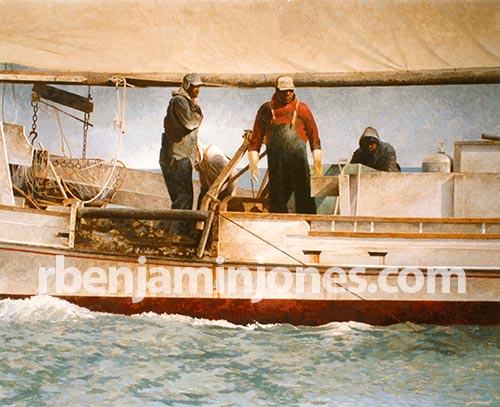Oyster Dredging (1992)
When I first went to the Eastern Shore in search of skipjacks and watermen, I was full of a certain romance about the whole thing-------Moby Dick and all that. It did not take long to see that this is a hard industry, more akin to what happens on the dark bowels of Bethlehem Steel than to a cruise on the bay. Out at three in the morning on a dark , wintry bay these men labor for what has become little profit. Listen to James Michener describe the work:
Now the muscle-work began. Port and starboard stood two winched, powered by hand, and around the drum of each, the wire leading to its dredge was wound. Then the men, two to a winch, began turning the heavy iron handles, and as the drums revolved , the irons holding the iron prongs of the dredge caught in rock,reversing the handle and knocking out the men's teeth or breaking their arms. Few watermen ever worked the oyster bars without suffering some damage from reversing handles: one of the younger Turlocks carried a broad scar across his forehead--" I like to died from bleedin' - lessen I had a head like rock, I be dead"
When the dredges finally climbed aboard, dripping with mud and weed, their cargo was dumped on deck, except when the load was simply too dirty to work; then the men engaged in a maneuver that almost jerked their arms from the sockets. Alternately lowering the dredge into the sea a few feet , and yanking it back, they sloshed the great net up and down until the mud washed free. Only then were they allowed to bring it aboard with its load of oysters and shells.
------- Chesapeake
Canvas - $255
Giclée - $250
Note Card - $3
Prints are 85-95% of original size, except where noted otherwise.
Dimensions of Original: 25.25"W x 21.5"H
